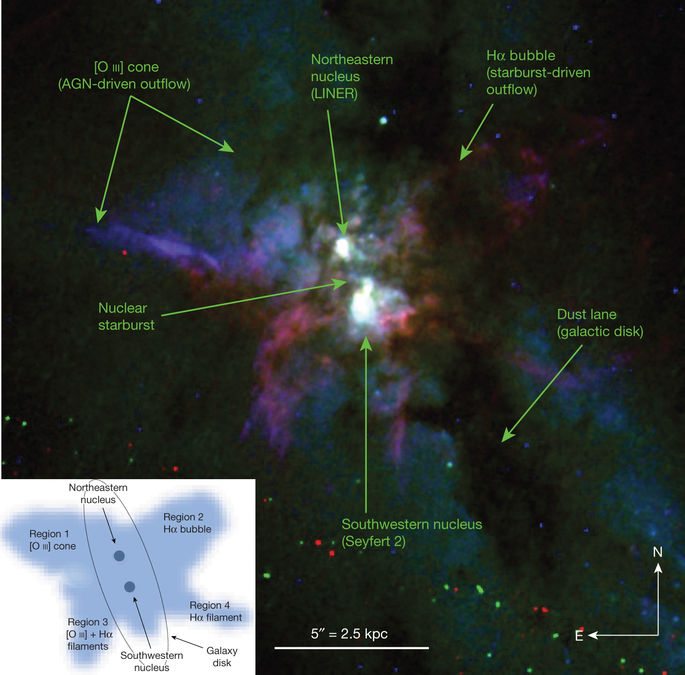Our official English website, www.x-mol.net, welcomes your
feedback! (Note: you will need to create a separate account there.)
Two separate outflows in the dual supermassive black hole system NGC 6240
Nature ( IF 50.5 ) Pub Date : 2018-04-01 , DOI: 10.1038/s41586-018-0033-2 F. Müller-Sánchez , R. Nevin , J. M. Comerford , R. I. Davies , G. C. Privon , E. Treister
Nature ( IF 50.5 ) Pub Date : 2018-04-01 , DOI: 10.1038/s41586-018-0033-2 F. Müller-Sánchez , R. Nevin , J. M. Comerford , R. I. Davies , G. C. Privon , E. Treister

|
Theoretical models and numerical simulations have established a framework of galaxy evolution in which galaxies merge and create dual supermassive black holes (with separations of one to ten kiloparsecs), which eventually sink into the centre of the merger remnant, emit gravitational waves and coalesce. The merger also triggers star formation and supermassive black hole growth, and gas outflows regulate the stellar content1–3. Although this theoretical picture is supported by recent observations of starburst-driven and supermassive black hole-driven outflows4–6, it remains unclear how these outflows interact with the interstellar medium. Furthermore, the relative contributions of star formation and black hole activity to galactic feedback remain unknown7–9. Here we report observations of dual outflows in the central region of the prototypical merger NGC 6240. We find a black-hole-driven outflow of [O iii] to the northeast and a starburst-driven outflow of Hα to the northwest. The orientations and positions of the outflows allow us to isolate them spatially and study their properties independently. We estimate mass outflow rates of 10 and 75 solar masses per year for the Hα bubble and the [O iii] cone, respectively. Their combined mass outflow is comparable to the star formation rate10, suggesting that negative feedback on star formation is occurring.Observations of NGC 6240 show two differently driven outflows of different gases with a combined outflow rate comparable to the star formation rate, suggesting possible negative feedback on star formation.
中文翻译:

双超大质量黑洞系统NGC 6240中的两个独立流出
理论模型和数值模拟已经建立了星系演化的框架,其中星系合并并产生双超大质量黑洞(间隔为 1 到 10 千秒差距),最终沉入合并残余物的中心,发出引力波并合并。合并还引发了恒星形成和超大质量黑洞的生长,气体流出调节了恒星的含量1-3。尽管这一理论图景得到了最近对星暴驱动和超大质量黑洞驱动的外流4-6 的观测的支持,但仍不清楚这些外流如何与星际介质相互作用。此外,恒星形成和黑洞活动对银河反馈的相对贡献仍然未知7-9。在这里,我们报告了对原型合并 NGC 6240 中心区域双流出的观察结果。我们发现 [O iii] 的黑洞驱动流出到东北和星暴驱动的 Hα 流出到西北。流出的方向和位置使我们能够在空间上隔离它们并独立研究它们的特性。我们估计 Hα 气泡和 [O iii] 锥体的质量流出率分别为每年 10 和 75 个太阳质量。它们的组合质量流出率与恒星形成率相当10,表明正在发生恒星形成的负反馈。 NGC 6240 的观测显示不同气体的两种不同驱动流出,其组合流出率与恒星形成率相当,表明可能存在负反馈关于恒星形成。我们发现 [O iii] 的黑洞驱动流出到东北和星暴驱动的 Hα 流出到西北。流出的方向和位置使我们能够在空间上隔离它们并独立研究它们的特性。我们估计 Hα 气泡和 [O iii] 锥体的质量流出率分别为每年 10 和 75 个太阳质量。它们的组合质量流出率与恒星形成率相当10,表明正在发生恒星形成的负反馈。 NGC 6240 的观测显示不同气体的两种不同驱动流出,其组合流出率与恒星形成率相当,表明可能存在负反馈关于恒星形成。我们发现黑洞驱动的 [O iii] 流出到东北,而星暴驱动的 Hα 流出到西北。流出的方向和位置使我们能够在空间上隔离它们并独立研究它们的特性。我们估计 Hα 气泡和 [O iii] 锥体的质量流出率分别为每年 10 和 75 个太阳质量。它们的组合质量流出率与恒星形成率相当10,表明正在发生恒星形成的负反馈。 NGC 6240 的观测显示不同气体的两种不同驱动流出,其组合流出率与恒星形成率相当,表明可能存在负反馈关于恒星形成。流出的方向和位置使我们能够在空间上隔离它们并独立研究它们的特性。我们估计 Hα 气泡和 [O iii] 锥体的质量流出率分别为每年 10 和 75 个太阳质量。它们的组合质量流出率与恒星形成率相当10,表明正在发生恒星形成的负反馈。 NGC 6240 的观测显示不同气体的两种不同驱动流出,其组合流出率与恒星形成率相当,表明可能存在负反馈关于恒星形成。流出的方向和位置使我们能够在空间上隔离它们并独立研究它们的特性。我们估计 Hα 气泡和 [O iii] 锥体的质量流出率分别为每年 10 和 75 个太阳质量。它们的组合质量流出率与恒星形成率相当10,表明正在发生恒星形成的负反馈。 NGC 6240 的观测显示不同气体的两种不同驱动流出,其组合流出率与恒星形成率相当,表明可能存在负反馈关于恒星形成。
更新日期:2018-04-01
中文翻译:

双超大质量黑洞系统NGC 6240中的两个独立流出
理论模型和数值模拟已经建立了星系演化的框架,其中星系合并并产生双超大质量黑洞(间隔为 1 到 10 千秒差距),最终沉入合并残余物的中心,发出引力波并合并。合并还引发了恒星形成和超大质量黑洞的生长,气体流出调节了恒星的含量1-3。尽管这一理论图景得到了最近对星暴驱动和超大质量黑洞驱动的外流4-6 的观测的支持,但仍不清楚这些外流如何与星际介质相互作用。此外,恒星形成和黑洞活动对银河反馈的相对贡献仍然未知7-9。在这里,我们报告了对原型合并 NGC 6240 中心区域双流出的观察结果。我们发现 [O iii] 的黑洞驱动流出到东北和星暴驱动的 Hα 流出到西北。流出的方向和位置使我们能够在空间上隔离它们并独立研究它们的特性。我们估计 Hα 气泡和 [O iii] 锥体的质量流出率分别为每年 10 和 75 个太阳质量。它们的组合质量流出率与恒星形成率相当10,表明正在发生恒星形成的负反馈。 NGC 6240 的观测显示不同气体的两种不同驱动流出,其组合流出率与恒星形成率相当,表明可能存在负反馈关于恒星形成。我们发现 [O iii] 的黑洞驱动流出到东北和星暴驱动的 Hα 流出到西北。流出的方向和位置使我们能够在空间上隔离它们并独立研究它们的特性。我们估计 Hα 气泡和 [O iii] 锥体的质量流出率分别为每年 10 和 75 个太阳质量。它们的组合质量流出率与恒星形成率相当10,表明正在发生恒星形成的负反馈。 NGC 6240 的观测显示不同气体的两种不同驱动流出,其组合流出率与恒星形成率相当,表明可能存在负反馈关于恒星形成。我们发现黑洞驱动的 [O iii] 流出到东北,而星暴驱动的 Hα 流出到西北。流出的方向和位置使我们能够在空间上隔离它们并独立研究它们的特性。我们估计 Hα 气泡和 [O iii] 锥体的质量流出率分别为每年 10 和 75 个太阳质量。它们的组合质量流出率与恒星形成率相当10,表明正在发生恒星形成的负反馈。 NGC 6240 的观测显示不同气体的两种不同驱动流出,其组合流出率与恒星形成率相当,表明可能存在负反馈关于恒星形成。流出的方向和位置使我们能够在空间上隔离它们并独立研究它们的特性。我们估计 Hα 气泡和 [O iii] 锥体的质量流出率分别为每年 10 和 75 个太阳质量。它们的组合质量流出率与恒星形成率相当10,表明正在发生恒星形成的负反馈。 NGC 6240 的观测显示不同气体的两种不同驱动流出,其组合流出率与恒星形成率相当,表明可能存在负反馈关于恒星形成。流出的方向和位置使我们能够在空间上隔离它们并独立研究它们的特性。我们估计 Hα 气泡和 [O iii] 锥体的质量流出率分别为每年 10 和 75 个太阳质量。它们的组合质量流出率与恒星形成率相当10,表明正在发生恒星形成的负反馈。 NGC 6240 的观测显示不同气体的两种不同驱动流出,其组合流出率与恒星形成率相当,表明可能存在负反馈关于恒星形成。











































 京公网安备 11010802027423号
京公网安备 11010802027423号